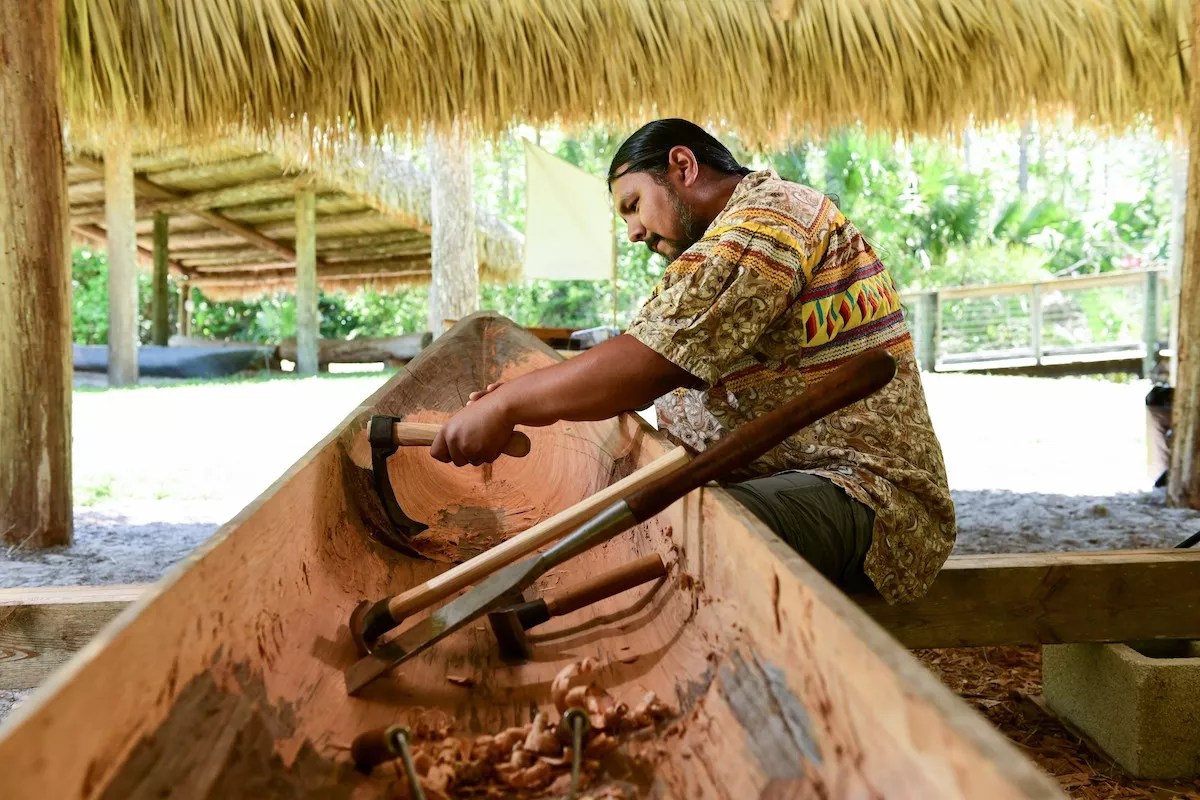
Photo by Yamila Images

Audio By Carbonatix
When Seminole artist and master canoe carver Pedro Zepeda begins a project, he starts by finding just the right tree. Traditionally, a dugout canoe is made from a single cypress log. Walking around Big Cypress Seminole Reservation, Zepeda typically looks for larger logs that have already fallen or died of natural causes. Thanks to logging in the first half of the 20th Century, old-growth cypress are rare. If the tree is too big to pull out of the woods, sometimes he’ll work on it right there in the forest until it’s light enough to move; otherwise, he’ll get someone to help him transport it to his workspace.
“It’s a continuing tradition for us – we’ve never not made dugout canoes,” Zepeda says, “I’m not trying to re-create a historical process; I’m just continuing a tradition that’s never been broken.”
HistoryMiami Museum visitors will get a chance to peek inside Zepeda’s process Saturday, November 9, during a public presentation of his process. He joins a wide variety of traditional artists, musicians, and craftspeople for the museum’s third-annual CultureFest 305, a full-day celebration of the cultural cornucopia that makes Miami unique. Attendees can listen to Irish, Brazilian, and Venezuelan music performances; watch a Haitian drum and dance demonstration; play Cuban dominoes; and attend interactive workshops on chocolate-making and Puerto Rican bomba dance. Local food and drink vendors such as Azúcar Ice Cream Company and Beat Culture Brewery will also be on hand.
For his demonstration, Zepeda plans to continue carving a canoe he started in August. Working from a 14-and-a-half-foot cypress trunk, he began constructing the boat at his workspace at the Ah-Tah-Thi-Ki Museum, where he is a teacher and demonstrator. He then transferred it to HistoryMiami, where visitors to CultureFest will be able to watch him in action, ask questions about his vision, and learn more details about canoe carving.
“For this canoe, I’m planning on doing something a little bit less traditional,” he says. “It’s going to have a traditional form for Seminole canoes, but I would like to add some sort of painting or carving to it to make it a little more expressive.” He’s not sure exactly what that will look like yet, but he says he might use symbolism or stylized imagery to more directly convey the important connection between the Seminole community and the water.

Photo by Yamila Images
Zepeda’s process generally blends the traditional with the modern. “I’m starting with the same base material, and I keep the shape pretty much the same as it has been for at least the last 120 years or so,” he says. He doesn’t shy away from using modern equipment such as chainsaws, but he prefers to use hand tools such as an adze. The tool resembles an ax but has a blade perpendicular to the handle, making it easier for scooping and digging inside a canoe. He also uses satellite imagery to help him find areas where larger cypress trees might be growing.
“I definitely am a fan of history, but I also feel it’s really important to show the modern side of native people,” Zapeda says. “It’s important to have both of those elements.”
Zepeda is experienced in other traditional Seminole arts as well, including basketry, sewing, and leatherwork. He cites his grandmother Tahama Osceola as a major inspiration. Osceola, a seamstress who specialized in traditional patchwork clothing, fed her grandson’s curiosity about Seminole art and encouraged him to learn the tribe’s language. At the age of 14, Zepeda began learning carving from his brother Brian and other members of the community. By his early 20s, he was working on full-size canoes. He later earned a degree in fine arts from Stetson University, where he focused on ceramic sculpture and drew inspiration from artists such as Salvador Dalí.
Though dugout canoes aren’t used for transportation by the Seminole community as often as they once were, Zepeda still wants to maintain this important aspect of his culture and encourage people to continue making and using the boats. After CultureFest, his canoe will head to History Fort Lauderdale, where it will be part of a larger exhibit showing the work of Seminole artists. He hopes CultureFest will offer people outside his community a chance to learn more about Seminole culture, past and present.
“It’ll be a great opportunity to teach the local community about my Seminole community – who we are and where we’re from and where we’re going,” he says. “One of the things I want people to know is the modernity of Seminole people and how we still exist. We’re part of the current culture and environment of Florida. We’ve been in this environment for quite a long time and learned a lot from it, and we try to maintain all those teachings from our elders and our families.”
CultureFest 305. Noon to 6:30 p.m. Saturday, November 9, at HistoryMiami Museum, 101 W. Flagler St., Miami; 305-375-1492; historymiami.org. Admission is free.